What type of tires you run on your recreational vehicle is a highly debated topic in the RV community. Most people understand that RV tires need to be replaced every 4-6 years depending on the care and use of the tires. But, when it comes to buying new tires it gets a little shaky when you ask them what they look for in a tire.
Since I began this RV life I have seen so many numbers it makes my head spin. There is a letter and weight calculation for every aspect of towing, pulling, pushing, lifting, and carrying the loads. Certainly, you know what I am talking about.
- UVW (Unloaded Vehicle Weight)
- GVW (Gross Vehicle Weight)
- GVWR (Gross Vehicle Weight Rating)
- CCC (Cargo Carrying Capacity)
- GAWR (Gross Axle Weight Rating)
- Tongue Weight (for travel trailers)
- Pin Weight (for fifth wheels)
- Curb Weight
When it comes to RV tires the letters and numbers don’t stop.
- Tire Pressure
- Load Rating
- Speed Rating
- Tire Size
- Tire Width
- Construction
- Diameter
It goes on and on!
So, how do we know what all these letters and numbers mean?
Well, we are here to help make sense of all that mumbo jumbo.
Tire descriptions can be found on the sidewall, represented by an alphanumeric code indicating the tire type, width, aspect ratio, construction type, wheel diameter, load index, and speed rating.
Disclosure: First and foremost, refer to your owner’s manual for manufacturers recommended information and guidance whenever possible. This article gives a broad overview and food for thought about RV tires and staying safe during travel.
So, understanding each RV and tire situation can be different.
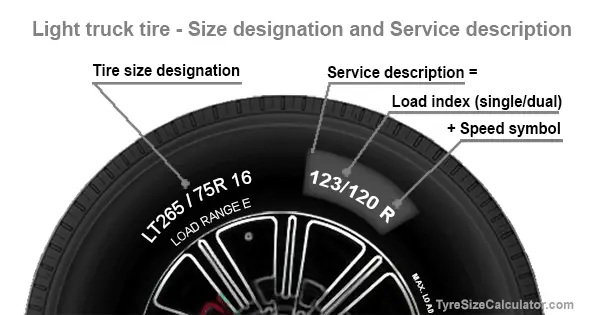
RV tire Type
Check the tire’s sidewall for a series of letters and numbers 11 to 13 characters in length. Using the first letter as seen above we can tell the type of tire we have. From the list below we should be able to determine the type of vehicle it is used for.
P: For a code starting with a P, the tire is made for passenger vehicles like typical sedans, minivans, and most smaller SUVs and light pickup trucks. So, mechanics commonly refer to these as P-metric tires.
LT: The LT code designates use for RVs, full-size pickup trucks, and SUVs that are a little heavier. This acronym stands for “light truck” and these tires are typically made for carrying heavy loads or towing trailers.
ST: Typically seen on a variety of trailers, ST stands for “special trailer.” Tires with the ST designation should never be used on cars, vans, SUVs, or any other type of passenger vehicle.
RV tire Width
Next after the tire type, we will find a three-digit number representing the tire width. This number may be a little hard to figure out and that is because the tire width is measured in millimeters.
So, when you see a number like 195 or 215, then the tire width measures 195 mm or 215 mm. This is one of the main numbers used for finding replacement tires at your local tire store. The tire width is also used to calculate the aspect ratio we will talk about next.
Aspect Ratio
Moving to the right we will see a forward slash followed by 2 digits. These 2 digits represent the tire’s aspect ratio or the ratio of tire height to the tire width.
To figure a tire’s height we measure from the rim of the wheel to the peak of the tire tread. This number is a percentage that you will see on the sidewall of the tire.
Think of the tire aspect like this. So, “If a tire has an aspect ratio of 70, it means the tire’s height is 70% of its width.”
Construction Type
After the width and tire ratio, we will find another letter, an R or D.
R: The R stands for “radial tires,” which have superior road grip, gas mileage, and ride comfort. This is the most common construction type seen on modern-day cars. Radial tires are made with multiple layers of rubber-coated cords laid perpendicular to the direction of travel.
These cords are made using a blend of polyester, steel, and fabric to improve overall tire durability. you may also remember hearing the term “steel belted tires” on many TV and radio commercials.
D: The D designation corresponds to bias tires. These tires have diagonal or crisscrossed cord plies and are sometimes used on motorcycles and trailers. However, this tire construction type isn’t common for the average passenger vehicle. It is a construction we would definitely not want to run on a heavy recreational vehicle.
Wheel Diameter
Two digits should be listed after the construction type. These numbers express the diameter of the wheel in inches. This means that if the number provided is 17, then the tire is designed to fit on a 17-inch wheel. Mind that this number isn’t a measurement of the tire’s tread-to-tread diameter; it represents the internal diameter from the two bead seat areas on the inside of the tire so that you know the appropriate wheel size for the tire.
Load Index
The tire load index is a code that references the amount of weight a single tire can handle. It’s listed as a two- or three-digit number after the wheel diameter. To determine the weight in pounds, refer to a load index chart like the one provided below. Once you find the load capacity for one tire, then (assuming all of your tires’ load capacities match) you can calculate your vehicle’s maximum load by multiplying the single tire load capacity by four.
(There are more ratings but the below ratings are the only ones we think relate to RV use)
108 = 2,205 lbs
111 = 2,403 lbs
114 = 2,601 lbs
117 = 2,833 lbs
120 = 3,086 lbs
121 = 3,297 lbs
122 = 3,307 lbs
Why Is Tire Load Index Important?
The tire load index tells you how much weight your tire can carry, and overloading your tires is never a good idea! When you put too much weight on your tires, you can cause damage and wear them down prematurely. Even worse, you run the risk of experiencing a tire blowout. So, choose your next tire carefully.
Tire load ratings can affect your ride’s performance, especially if you haul or tow materials, goods, boats, trailers, and so on.
How to determine the load rating you need for your RV
To roughly determine the tire load range capacity for each individual truck tire, take the vehicle’s gross weight and divide it by four. If the vehicle’s gross weight is 11,500 pounds, each tire should be able to safely support at least 2,875 pounds.
You might think dual-wheel axles can carry a lot more just because they have twice the amount of tire support under them. Normally this is true – but what happens to that configuration if one of the tires on one side fails? You now have ONE tire on that side supporting a load of TWO, regardless of the load rating of the tires. So, if you look at the load rating label on the light truck tire below you will find that the very same tire used as a single-wheel axle tire has a much less conservative load rating than it does when used on a dual axle.
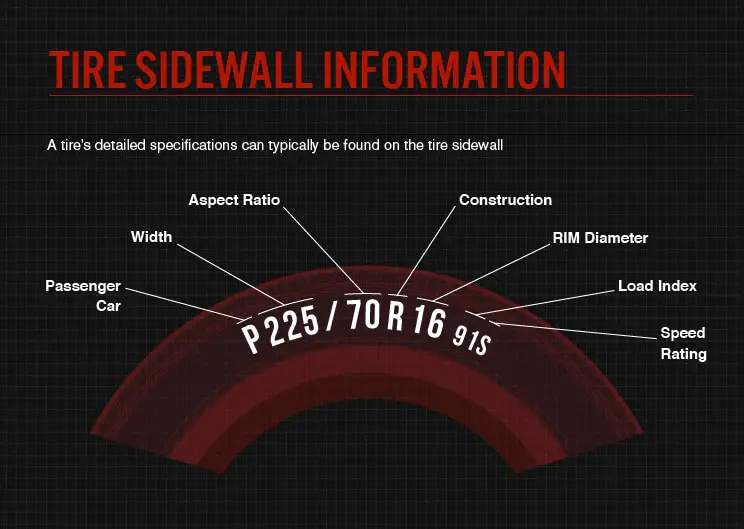
Speed Rating
Similar to the load index, tire speed ratings indicate the maximum speed for which a tire is rated. The tire speed rating is often represented by a letter, but it can also be a letter and a number. In rare cases where the speed rating exceeds 186 mph, it may be designated by a ZR followed by (Y). So, see below the speed rating chart for what fits your needs.
(There are more ratings but the below ratings are the only ones we think relate to RV use)
L = 75 mph
M = 81 mph
N = 87 mph
P = 93 mph
Q = 99 mph
R = 106 mph
S = 112 mph
Why is Tire Speed Rating Important?
A tire speed rating is the maximum speed tires can safely travel for optimum performance and life expectancy. Exceeding this speed can cause increased wear and tear on the tires. As the tires exceed the speed rating, there’s more friction between them and the road.
Running a tire at speeds higher than its rating can shorten the tire’s life and potentially lead to tire damage which could result in an accident, so it is important to follow the manufacturer’s speed rating recommendations when you are choosing tires.
How old are your tires?
One of the most important numbers to know about RV tires is when they were made. So, this is a number you definitely want to know.
Check (TIN) tire identification number or “DOT” number. According to DOT regulations, this identification must begin with the letters DOT, followed by eight to 13 characters. The DOT information often identifies the manufacturing location by a code, tire size code, and type code, followed by the week and year the tire was manufactured.
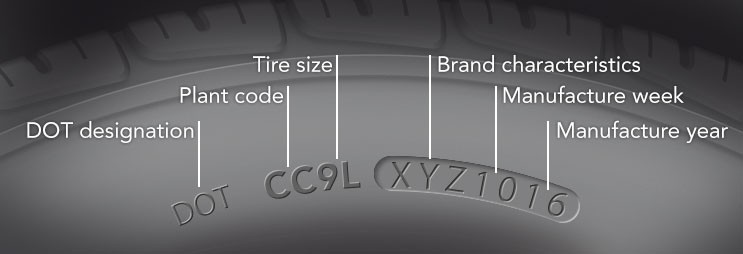
What is Tire Air Pressure (PSI) and Why It Matters
PSI, or pounds (of force) per square inch, is the unit of pressure chosen by most people in the US to represent tire air pressure. Maintaining the proper tire air pressure is a matter of safety for you, the passengers you may have, and the vehicles that may be around you.
Low RV tire pressure
Driving your motorhome or towing your travel trailer or 5th wheel with the wrong level of tire pressure can lead to all sorts of problems, affecting your stability, ease of ride, and even gas mileage.
First, tire blowouts are caused by underinflation. Underinflation will force tires to come into contact with the ground more than properly inflated tires would.
Second, the sides, or shoulders, of tires flex more when overinflated which produces an excessive amount of heat, and excessive amounts of heat lead to tire failure.
Lastly, If your tires are under-inflated by just 10 or 15 psi, then the temperatures on the sides of the tires can reach 200 degrees Fahrenheit. So, you can see why monitoring tire pressure is of the utmost importance.
Overinflated RV tires
The over-inflation of tires makes the sidewalls and tread of the tire harder than normal. This can limit the performance and traction of the tire. Also, it may cause uneven tire wear.
Also, tire pressure that is too high can cause a slight increase in gas mileage by reducing the rolling resistance of your tires.
Plus, overinflation will lead to a harsh ride, wobbly handling in the wind, and reduced braking effectiveness which is especially reduced on wet roads. If you’re towing a travel trailer, it could also lead to sway issues. Clearly, you can see overinflation is not any safer than underinflation when it comes to tires.
Where can I find my tire pressure?
- On the Tire Itself (Sidewall)
- Owner’s Manual
- On the Sticker Inside the Vehicle
- Doorpost
- Tire Placard on the Edge of a Vehicle’s Door
- Glove Box Door
- Fuel Door
How to Determine the Correct Tire Pressure for Your RV
Setting the correct tire pressure on tires on your RV is crucial to tire performance, tire life, vehicle handling, and, most importantly, the safety of you and the people that are around you.
In order to get the best possible tire pressure, you should base your figures on the load being carried by the tires.
When you base the tire pressure on the load being carried by your tires, you ensure that the tires flex properly, are in the correct shape, will not produce an excessive heat build-up, and provide the strength to carry the total weight of your RV without losing tire patch (contact with the road). For this reason, we need to keep the rubber on the road.
How To Monitor Your RV’s Tire Pressure
Monitor your tire pressure with a tire pressure monitoring system (TPMS). Your RV might have one pre-installed, but if it does not, then simply buy one and install it in your RV.
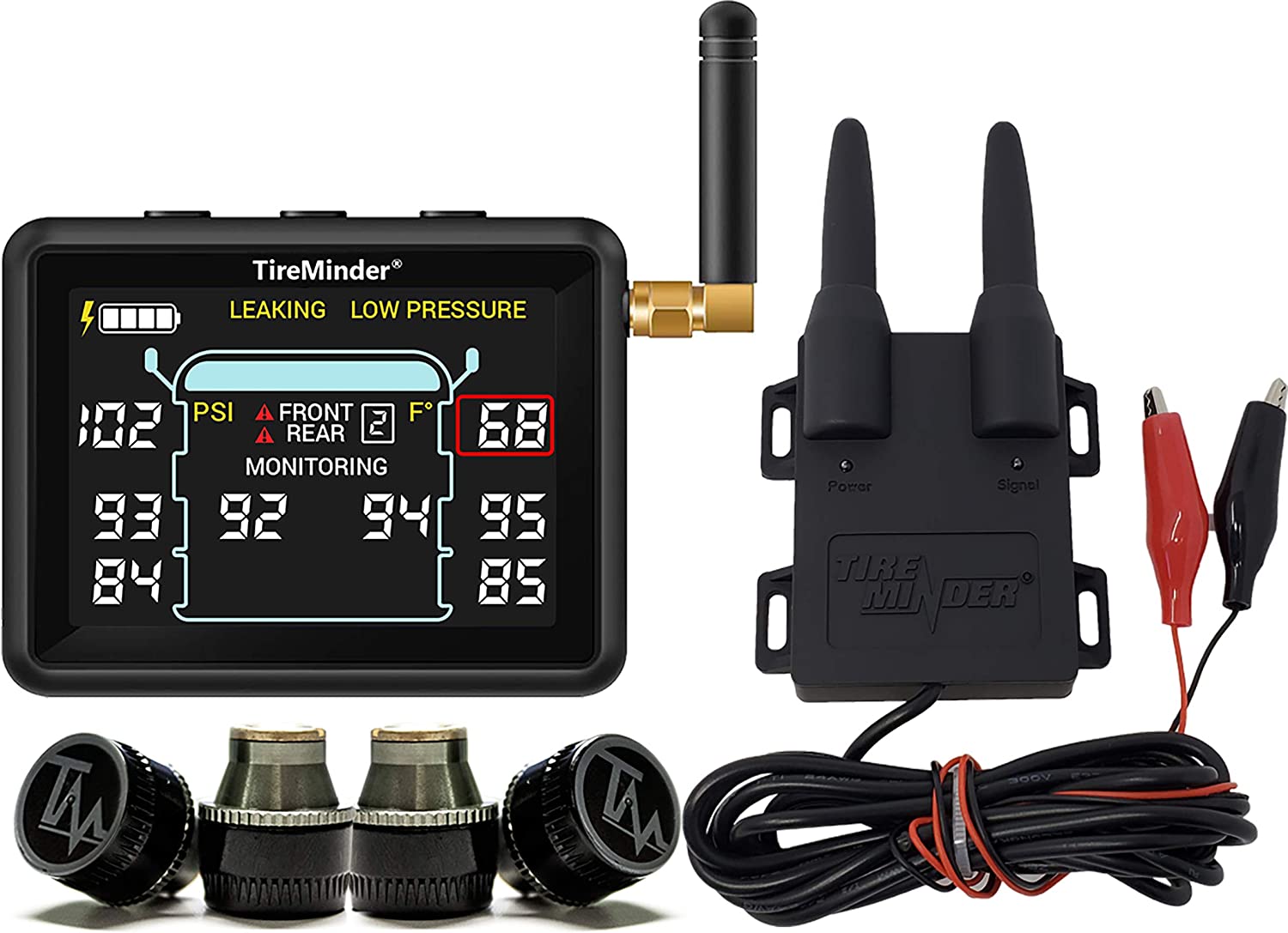
Everything you need to know about tire pressure monitoring systems for RVs
You could monitor your tire pressure the old fashion way with a tire pressure gauge too. Digital tire pressure gauges are a decent option. So, this is an inexpensive way to check tire pressure and travel safely.
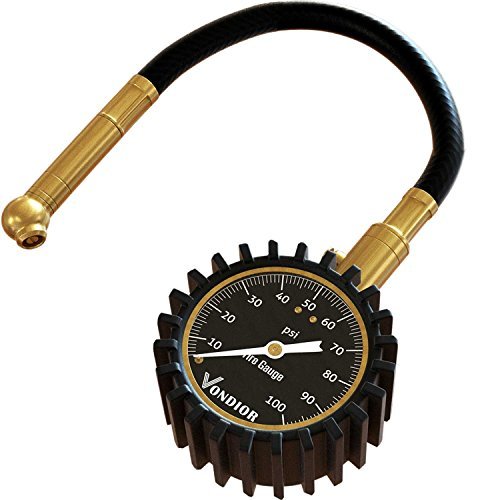
A beneficial situation for all mankind. When tires are not properly inflated, they are less “round” and require more energy to begin moving and to maintain speed. In addition, under-inflated tires contribute to pollution and increased fuel costs. So get a VONDIOR gauge in order to save money and Mother Nature.
This may seem like common sense, but some people do not realize that tires lose air pressure over time. They lose around 1 pound per square inch (PSI) every thirty days, and they lose around 1 pound per square inch for every 10-degree (Fahrenheit) decrease in temperature. So, check, check, check!
What to think about!
When we think about the weight of our RVs don’t forget everything you are loading into it. Fuel, water, camping supplies, and all the people add up quickly. Besides the weight, we find out our RV can handle, remember all that weight is landing directly on your tires. So, can they hold the weight?
Another thing is to not take your weight to the limit. It is hard, but I try to leave a 20% window from my max carry weight to what my RV actually weighs.
Do you know how much your RV weighs when it is loaded for a trip? The tanks are full and ready to go!
You can usually go through a truck weigh station and have it weighed. This is important for the safety of you, your family, and everyone else on the road.
This is a listing of commercial tires for Class C motorhomes built on a Ford E450 chassis that can be found by Googling “225/75R16C 121R”
- Firestone Transforce CV Commercial HT 225/75R16C 121R
- Continental Vancontact 225/75R16 121R
- Continental Vancon 225/75R16C 121R
- General Grabber HD Commercial Truck Tire – 225/75R16 121/120R
- Goodyear Wrangler Fortitude HT® 225/75R16 121R
- Hankook Pathfinder HSR 225/75R16 121R
- Hercules Terra Trac CH4 Light Truck Tire LT225/75R16 123R
- Kumho HT51C LT225/75R16C 121/120R All-Season Tire
- Michelin Agilis CrossClimate 227/75R16C 121/120R
- Nexen Roadian CT8 HL All-Season Tire – LT225/75R16 121R 40,000-mile warranty
- Nokian Tire WRC 225/75R16 121R
- Toyo Celsius Cargo Tire – 225/75R16 121/120R E/10 CSCG TL
Search for commercial RV tires and prices
Recent Articles
5 Class C’s featuring a King size bed




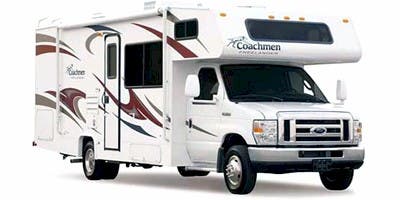
One thought on “The Ultimate Guide for Buying new RV Tires”